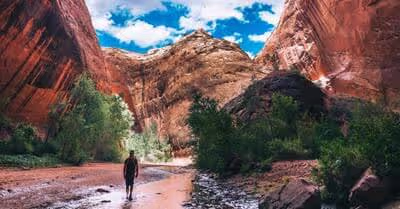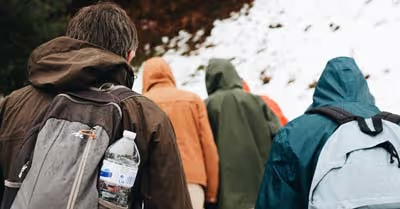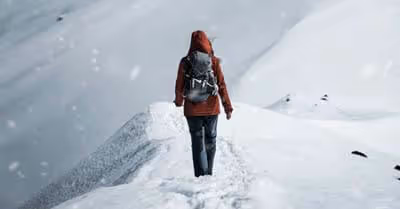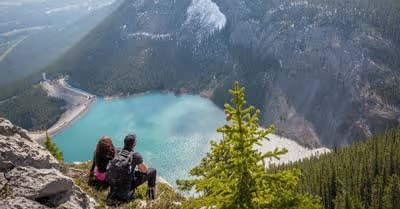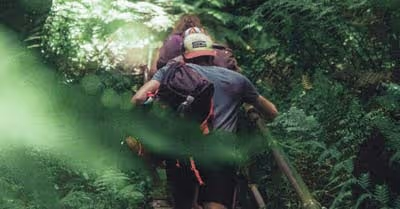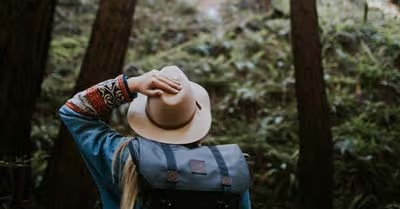Table of Contents
Basics Of What To Wear Hiking
When you are hiking, there are a few things that you will pretty much always want to bring with you. The basics, as it were. First of all, hiking boots, or running shoes. Some kind of comfortable footwear with good traction. Hiking boots are generally safer and give you the support you need, especially on steep inclines or when scrambling over loose rocks. Hiking boots have high ankle supports which are very handy when you are scrambling, because slipping means your ankles will be locked into place. They won't roll over as easily. However, they could break because there is no give. Running shoes are more comfortable on flat trails and offer you enough grip for most situations. They aren't waterproof, as many hiking boots are, but they do breathe a lot better. Which is more comfortable especially in very hot conditions. There is a lot of arguing in the hiking community when discussing what footwear is best. My advice would be hiking boots unless the trail is pretty flat.
You will also need to wear socks. Hiking or walking socks are designed to be a little thicker, and higher up on your feet, than dress socks. They help keep your feet warm and also cushion them a bit. Hiking boots tend to have a bit more room at the ends than regular shoes. This is for comfort, however, without hiking/walking socks this can mean your feet keep slipping around and even hitting the ends. Which is a good way of getting blisters and bruises on your toes. Some people prefer to wear dress socks under their hiking socks for extra padding, comfort, and support. Just make sure you don't cut off your circulation.
Hiking pants are ordinarily whatever clothes you choose to wear. If you are hiking in hot temperatures, hiking shorts are far more comfortable, if you are hiking in very cold temperatures thicker pants with perhaps an internal layer (or two) to keep you warm. Hiking pants are generally water-resistant, with multiple deep pockets, to give you as much versatility as possible. They may not be "cool" but hiking pants that zip off the bottom of the legs and turn into shorts are awesome for multi-day hikes. Start the day off with full-length pants, when it starts to get warmer turn them into shorts if you start to get cold simply re-attach your pant legs. If you are hiking through very cold areas, it's going to snow not just rain, then you might want to pick up a pair of thick long johns! They are essentially leggings, but for anyone not just women. If you have been skiing before you have likely worn them under your pants. They are very warm and very comfy! They also offer some extra padding if you are to slip and fall on the icy ground.
When you are hiking it's a good idea to check the weather before you go and then dress accordingly. When you are hiking and it's particularly hot, you will probably want loose layers that breathe quite well. A loose-fitting t-shirt will be more comfortable than a long-sleeved sweater. What many people don't consider is that in very hot, very sunny, climates it's a good idea to wear longer layers. Having long loose sleeved shirts can stop the sun from beating down on your skin so much. This can prevent sunburn. Conversely, covering as little of your skin as possible will allow your body to "breath" better.
In very cold temperatures, one shirt isn't always enough. The best way to keep warm is to wear many layers, not thicker layers. The reason being that the air in between each layer that is trapped warms up and stays warm, from your body temperature, which helps protect you from the elements. Wearing a tank top, a T-shirt, and then a sweater would be warmer than wearing 2 sweaters. A thermal undershirt can work wonders in extremely cold weather. It's got the same principle, it traps air against you much better. Make sure you get one with long sleeves to get the maximum benefit from it. Sports thermal undershirts generally work pretty well, the ones with a gap for your thumb to go through (so the sleeves don't ride up on your arm) can also help keep your hands warm.
When it comes to jackets, there are a few options in front of you. It's always a good idea to bring a thin raincoat with you, one of the kinds that fold up into a tiny pouch that can fit in your pocket should be good enough in places you don't expect rain. Like hiking through Utah in the summer months. A raincoat is generally pretty light and compact, so it's good to have one on hand. If you are hiking somewhere that rain is almost a guarantee, getting a thicker raincoat that can fit over your regular jacket is recommended. Most outdoor jackets are water-resistant, this means water will flow off them but they can still become wet and damp over time. If you are hiking in the snow, waterproof jackets are still recommended even though you likely won't be getting rain. Snowfall will melt on your jacket over time, if it isn't waterproof it'll eventually soak into your jacket and even your underlayers. Good luck getting dry when even your undershirt is damp!
When it comes to headwear, the climate is everything. Wearing a baseball cap is always a pretty safe bet, as the temperature doesn't often have anything to do with the sun being in your eyes! At least not in a significant way. Baseball caps will keep your head warm, the sun out of your eyes, and are pretty comfy generally. You might assume a baseball cap only serves a purpose in very hot and sunny conditions, but you're wrong. A baseball cap is perfect for keeping the rain and snow off your face. It can help you see through a storm, by giving you just a small amount of cover. Baseball caps will do this, SnapBacks with flat brims will not. The curvature of a baseball cap is what protects your eyes. When it's very cold, a beanie or wool hat is recommended. You are trying to cover as much of your head as possible with a thick layer. Especially your extremities (ears). We have all been walking in the cold, touched our ears, and been shocked to find out just how icy cold they get. You can't particularly feel your ears, you may notice the cold but not very much. When you stop being able to feel anything at all in your ears is when you know you have a problem.
Some extra comfort apparel
Not necessary but perhaps recommended for extra comfort are a few items that many people pass over. For example, would you think to bring a scarf? What if you were hiking in the desert? Bringing a scarf can serve a few purposes, even in hot temperatures, it can double as a rag to keep sweat out of your eyes. Which can sting and be quite unpleasant. It can protect you from the harsh sunlight on your neck, which can be very painful if you are already burnt. In very hot conditions, a light scarf can be wrapped around your head to keep the sun off your face and head. This is very common in Middle Eastern countries. Lastly, a scarf can double as a bandage if needs be. It can easily be tied around a wound to stop the flow of blood or double as a sling. It's a very handy device indeed!
Gel fitted soles on your shoes can help cushion your feet in rigid hiking boots. They can be fitted inside your sock and/or inside the sole of the shoe to offer extra padding. This padding can stop aches and pains in the joints and tendons, as well as stop you from getting blisters. Wearing ankle supports can also help ease the pain of walking long distances. Putting extreme pressure on your feet for days on end can result in serious medical conditions. Imagine getting gout halfway through a 5-day hike? What a nightmare. Ankle supports can also protect you from rolling your ankle If you happen to be hiking in running shoes instead of hiking boots. If you are wearing hiking boots, these supports will still help keep your ankles safe. Just less so. They won't stop you from breaking your ankle if your foot gets caught when you fall. So bringing hiking poles still might be a good idea.
Wearing gloves can be very beneficial, no matter the climate. Sure, wearing wool gloves in cold weather will obviously keep your hands warm. But wearing gripped fingerless gloves in any condition can help keep your hands warm and still give you the dexterity to use your phone, map, and compass. Gripped gloves can make it easier when you are scrambling over rough, jagged, rocks. If you fall, you shouldn't put your arms out to catch you or you may end up breaking them. But, If you slip and need to grab something like a branch or rock for support you will be able to do so without cutting up the palms of your hands. This is a good way of avoiding injury as well as discomfort.
This next suggestion is a bit different, but still equally valid. A step counter is a good way of keeping your pace. This item has been included in the comfort section because a step counter allows you to help keep the pace between locations and breaks. If you want to stay at a steady pace, and ensure you don't go too long without drinking, eating, or resting - then a step counter is very helpful. I like using a step counter so I can accurately estimate how far I've gone and how far I still have to go. It will give you a rough idea, even without an accurate GPS device.
What can you wear to keep you extra safe?
Some clothing items are not meant to be stylish, or comfortable, but are rather meant to keep you looking safe. Even at the expense of looking a little silly. A good example of this is a headlamp. A headlamp looks a little goofy, especially if it isn't currently dark when you are wearing it, but it is such a helpful item to have with you. Wearing a headlamp instead of holding a flashlight can offer the obvious benefits that this kind of device does while leaving you with one hand free. One hand to help you scramble over rocks, carry things or catch yourself If you fall. Additionally, a headlamp is always illuminating whatever you are looking at. It's generally just easier. Even if you might look silly wearing one in the middle of the day when the sun is still out.
A whistle is something that you can wear around your neck and then pretty much forget about. It weighs nothing, it will hardly be noticeable. But, should you need to alert people to your location, it can be a lifesaver. Truly! If you injure yourself calling out for help can be difficult or even impossible. Blowing into a whistle is far louder than you can yell and requires far less effort. It would also scare off a predator, like a coyote, before it can become a real problem for you. Some whistles even have a pepper spray canister attached to them for easy access. This spray won't be powerful enough for bears but most animals, or people, will be vulnerable to it if needs be.
Another cool little accessory is a paracord bracelet. This bracelet is worn on your wrist, as any other bracelet would be except it isn't just to make you look cool. The bracelet can be unwound into 50 or even 100 feet of paracord, which can be used for any number of purposes. It's a great way to ensure you always have a cord on you - even if you left your pack at camp and have gone off to do something or other in the woods. Gathering firewood, relieving yourself, etc.
Conclusion
So, now you have a good idea about everything you might need to wear on your next hike. Whether you are an experienced hiker or a complete rookie, refreshing your wardrobe to contain newer and better hiking apparel is a good idea. Clothing in the hiking niche is constantly being innovated. You will be able to find comfier, warmer, and lighter clothing every few years. Of course, there is always that one sweater or jacket that we always enjoy wearing. But that doesn't mean we can test the water a bit and see what's out there. Hopefully, this article has given you a few ideas about what you could bring hiking with you next time. Good luck on your next hike, stay safe on the trail, and remember to bring enough layers!
Recent Articles



